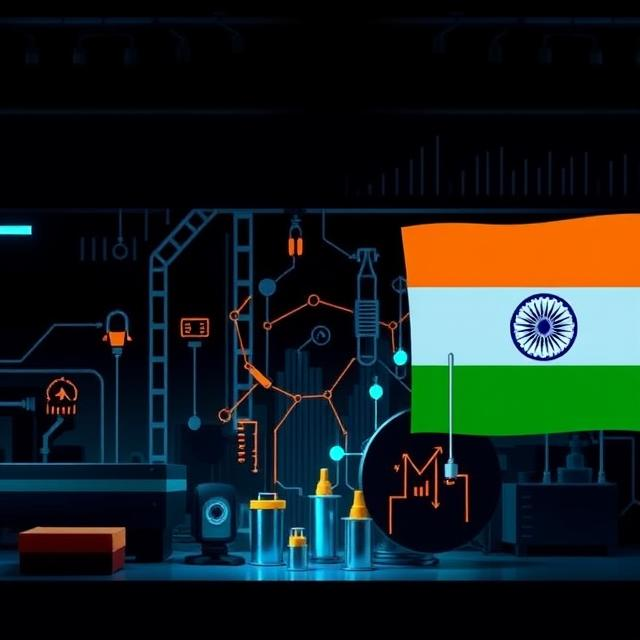Introduction
India, a fast-growing economy, has set ambitious goals for transforming its industrial sector, which plays a crucial role in driving economic growth, employment, and development. To achieve these goals, India has introduced various initiatives and policies that aim to boost the manufacturing sector, promote entrepreneurship, and create a conducive environment for innovation. Two key initiatives that are central to this vision are the National Manufacturing Policy (NMP) and the Make in India and Start-up India programs.
The National Manufacturing Policy, launched in 2011, aims to enhance the share of manufacturing in India’s GDP and create millions of jobs. Meanwhile, the Make in India initiative, launched in 2014, focuses on promoting India as a global manufacturing hub. On the other hand, the Start-up India scheme, introduced in 2016, seeks to foster a culture of entrepreneurship and innovation. Together, these policies form the backbone of India’s industrial strategy for growth, employment, and innovation.
This article critically examines the objectives of the National Manufacturing Policy, followed by an in-depth analysis of the Make in India and Start-up India initiatives, evaluating their successes, challenges, and overall impact on India’s economy.
National Manufacturing Policy: Objectives and Goals
The National Manufacturing Policy (NMP) was launched by the Indian government with the primary aim of improving the country’s manufacturing capabilities and increasing the contribution of the sector to the national economy. The policy seeks to make India a global manufacturing hub, provide employment opportunities, and create value-added products that meet both domestic and international demands.
Key Objectives of the National Manufacturing Policy:
- Increase the Share of Manufacturing in GDP: The National Manufacturing Policy aims to increase the contribution of the manufacturing sector to India’s GDP from 16% to 25% by 2022. This goal underscores the importance of expanding the manufacturing sector as a key driver of economic growth.
- Job Creation: A significant objective of the policy is to create 100 million additional jobs in the manufacturing sector by 2022. The government acknowledges that India’s workforce is predominantly young and that manufacturing can play a critical role in providing employment opportunities, especially for skilled and semi-skilled labor.
- Promotion of Investment and Innovation: The policy promotes investment in both existing and emerging industries, particularly in sectors like electronics, textiles, automobiles, machinery, and defense. By creating an enabling environment for innovation, the policy encourages the adoption of advanced technologies and sustainable practices within the manufacturing ecosystem.
- Skills Development: Recognizing the need for a skilled workforce to meet the growing demands of the manufacturing sector, the NMP focuses on enhancing skill development programs to ensure that workers have the necessary qualifications and expertise to thrive in modern industries.
- Infrastructure Development: The policy stresses the need for developing world-class infrastructure, including transportation networks, energy supply, and logistics, to ensure that manufacturing units have the resources required to operate efficiently and cost-effectively.
- Sustainability: The NMP also prioritizes sustainable development, encouraging the adoption of green technologies and processes that reduce the environmental impact of manufacturing activities. This aligns with global trends towards eco-friendly industrial practices.
Critical Examination of ‘Make in India’ Initiative
Launched by Prime Minister Narendra Modi in 2014, the Make in India initiative aimed to transform India into a global manufacturing hub by encouraging both domestic and foreign investment. The campaign sought to increase the manufacturing sector’s contribution to the GDP and create millions of jobs for India’s young population. The initiative sought to promote sectors such as automobiles, defense, electronics, textiles, chemicals, and more.
Objectives of Make in India:
- Boosting Manufacturing Sector: The primary goal of the Make in India campaign is to boost the manufacturing sector and increase its share in the GDP. By fostering innovation, investment, and skill development, the government aims to improve India’s position as a competitive manufacturing destination.
- Creating Employment: The initiative aims to generate millions of jobs in manufacturing and related sectors by encouraging industries to set up or expand their production facilities in India.
- Encouraging Foreign Direct Investment (FDI): Make in India focuses on attracting foreign investment by easing regulatory hurdles and providing a favorable investment climate. The initiative promotes India as a viable investment destination for multinational corporations and entrepreneurs.
- Infrastructure Development: Another key objective is to improve India’s infrastructure, including transportation, logistics, and energy supply, to ensure that manufacturers can access the resources they need to scale production.
Critical Analysis of Make in India:
Successes:
- Attracting Foreign Investment: The initiative has been successful in attracting significant foreign direct investment (FDI), particularly in sectors such as electronics, automotive, and defense. For instance, India’s electronics manufacturing sector has seen increased investments in production, leading to the growth of domestic manufacturing and export potential.
- Infrastructure Improvements: The Make in India initiative has led to improvements in infrastructure, particularly in logistics and transportation networks. This has contributed to reducing the cost of manufacturing in India, making the country more competitive.
- Increased Focus on Skill Development: The Make in India program has encouraged skill development initiatives that aim to create a workforce capable of meeting the demands of the modern manufacturing sector. The program has collaborated with educational institutions and industry bodies to create training programs and certifications.
Challenges:
- Regulatory Bottlenecks: While Make in India focused on easing regulatory processes, challenges remain in terms of bureaucratic hurdles and complex approval procedures, which continue to deter investors and entrepreneurs from setting up businesses.
- Infrastructure Gaps: Despite improvements, India’s infrastructure still faces significant challenges. Power shortages, poor roads, and limited access to reliable logistics networks continue to hinder the growth of manufacturing industries, especially in rural and remote areas.
- Skilled Labor Shortage: While there is a strong emphasis on skill development, India still faces a gap in skilled labor, particularly in advanced manufacturing fields. This has made it difficult for industries to adopt cutting-edge technologies and processes.
- Competition from Other Countries: India’s competition from neighboring countries like China, Vietnam, and Bangladesh in terms of labor costs and manufacturing efficiency continues to be a challenge for the success of the Make in India initiative.
Critical Examination of ‘Start-up India’ Initiative
The Start-up India initiative was launched by the Indian government in 2016 to foster entrepreneurship and promote the establishment of new businesses. The initiative aims to build a robust ecosystem for startups by providing them with access to funding, mentorship, and a supportive regulatory framework.
Objectives of Start-up India:
- Promote Entrepreneurship: Start-up India seeks to encourage young individuals to embrace entrepreneurship by reducing the challenges and barriers associated with starting a business in India. The government offers various schemes and incentives to help startups succeed.
- Providing Funding Support: One of the key goals of Start-up India is to enhance access to funding for startups. Through initiatives such as the Start-up India Seed Fund Scheme and a dedicated fund of funds, the government aims to provide startups with the necessary capital to scale their operations.
- Simplifying Regulatory Processes: The initiative aims to ease regulatory processes and provide a more conducive environment for startups to grow. This includes the introduction of self-certification schemes, tax exemptions, and the establishment of a single-window clearance system for faster approvals.
- Mentorship and Networking: Start-up India also focuses on providing startups with mentorship, networking opportunities, and access to incubators, accelerators, and industry leaders who can guide them in their entrepreneurial journey.
Critical Analysis of Start-up India:
Successes:
- Increase in Startups: Since its launch, Start-up India has contributed to the rise of thousands of startups across various sectors, including technology, healthcare, education, and agriculture. The initiative has helped transform India into one of the world’s largest startup ecosystems.
- Funding Support: The government has provided significant funding through schemes like the Fund of Funds for Start-ups (FFS), which has played a critical role in improving access to capital for early-stage startups.
- Regulatory Reforms: Regulatory reforms introduced under the Start-up India initiative, such as tax exemptions and easier business registration processes, have significantly reduced the burden on entrepreneurs.
Challenges:
- Limited Access to Funding: While funding has increased, many startups still face difficulties in accessing the capital they need, particularly in the early stages. Moreover, access to venture capital and angel investors is often restricted to businesses in major metropolitan areas.
- Support for Rural Startups: The focus of the initiative has largely been on urban centers, and rural startups face challenges in accessing resources and infrastructure needed to scale their businesses.
- High Failure Rates: The startup ecosystem in India still faces high failure rates due to several factors, including inadequate market research, lack of skilled personnel, and stiff competition from established companies.
- Implementation Gaps: Despite numerous initiatives, there are still significant gaps in implementation, particularly in terms of providing real-time support to entrepreneurs and ensuring that the schemes reach the target audience.
Conclusion
The National Manufacturing Policy, Make in India, and Start-up India initiatives are integral parts of India’s broader strategy for economic growth, industrialization, and job creation. While these initiatives have made significant progress, challenges such as regulatory bottlenecks, infrastructure deficits, and skill gaps remain, hindering their full potential.
For these initiatives to achieve their goals, it is essential to focus on strengthening the implementation mechanisms, improving infrastructure, and providing targeted support to underserved sectors and regions. By addressing these challenges, India can effectively realize its vision of becoming a global manufacturing hub and nurturing a vibrant startup ecosystem, contributing to long-term economic growth and employment generation.




